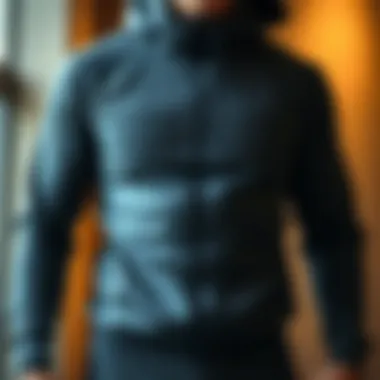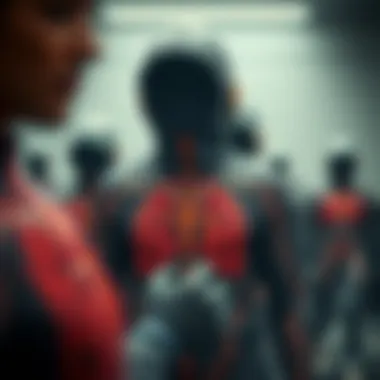Evaluating Full Body Sweat Suits for Effective Weight Loss


Intro
In the kaleidoscopic world of fitness fashion, full body sweat suits stand out as both a functional and controversial garment. These suits, often constructed from materials designed to retain heat, are marketed with bold promises of enhanced weight loss. But do they deliver on these claims? This article seeks to peel back the layers—much like the suits themselves—exploring the practical applications, effectiveness, and the science that underpins their use in weight loss regimens.
As trends shift and transform in the athletic wear industry, it's crucial to anchor ourselves in informed perspectives rather than fads. Understanding how these sweat suits operate within our bodies can provide clarity in navigating the landscape of weight loss techniques. Not just an item of clothing, these suits attract attention for their supposed benefits, but they also spark conversations on efficacy, safety, and social perceptions.
In the sections ahead, we will delve into the physiological responses of the body while wearing these suits, examine potential risks versus rewards, and discuss sound practices for incorporating them into exercise routines. Whether you're a fashion enthusiast hoping to blend fitness with style or a skeptic weighing the advantages, this comprehensive guide aims to offer valuable insights. Let's embark on this journey together, uncovering facts, debunking myths, and ultimately, empowering ourselves with knowledge.
Intro to Full Body Sweat Suits
Full body sweat suits often stir debate in fitness circles. These garments, designed to trap heat and induce perspiration during workouts, have gained a foothold in the landscape of fitness apparel. It's not just about style or keeping warm; it's about potential benefits in weight loss and workout efficiency. Understanding these suits requires a closer look at their historical context and current trends—both of which shape how they are viewed today.
Historical Context and Evolution
The journey of sweat suits is tied to various fitness trends over the decades. Initially popularized in the 1970s by boxers and athletes seeking to shed water weight before competitions, these suits have evolved dramatically since their inception. Early designs were often made from heavy materials that could restrict movement. Yet, as the fitness industry grew, so did innovations in fabric technology.
Modern sweat suits are constructed from lighter, breathable materials that retain heat without significantly hampering exercise. Notable are manufacturers such as Adidas and Under Armour, who have adopted advanced fabrics that wick moisture yet keep the wearer warm. This evolution has led to sweat suits being embraced by a wider audience, from casual gym-goers to enthusiasts trying to enhance their training regimen.
Current Trends in Fitness Apparel
Today, sweat suits are more than just a tool for weight loss; they are a fashion statement. As athleisure becomes a prevalent trend, these suits are designed to not only function effectively but also look good. Colors, styles, and even customization options have become focal points for brands vying for consumer attention. This intertwining of fitness and fashion means that people are increasingly aware of how they look while working out, making choices accordingly.
Moreover, social media has played a significant role in popularizing full body sweat suits. Platforms like Instagram and Facebook are inundated with influencers showcasing their stylish activewear, further pushing the narrative that sweat suits can be both practical and chic. This blend of functionality and aesthetics appeals to a broad demographic, including young adults looking to invest in fashionable yet effective workout gear.
"In the world of fitness, perception matters just as much as performance."
The growing acceptance of sweat suits in mainstream fitness and fashion culture reflects a significant shift in attitudes toward what it means to workout. As more individuals opt for these suits, it raises questions about their efficacy in weight loss, overall health, and the psychological factors influencing their use.
Understanding How Sweat Suits Function
Understanding how sweat suits function is central to grasping their role in weight loss strategies. These garments appeal to those seeking to shed pounds or enhance their workout effectiveness, and knowing how they operate can clarify the true value they offer. Sweat suits are designed to boost the body’s heat, inducing more sweat during physical activities. However, the question remains: is this just a tricky gimmick or does it carry actual benefits?
When it comes to the physiological effects, this section will explore the nitty-gritty about how these suits operate, focusing on two critical elements: the physiological mechanisms at play and their impact on thermal regulation.
Physiological Mechanism
At its essence, a sweat suit works on the principle of increasing body temperature, leading to perspiration. When you wear these snug, often plastic-lined suits, your body perceives a rise in heat. As a response, the body sweats more than it would without such clothing, which some believe aids in detoxifying and melting away fat.
The active components of this process include:
- Increased heart rate: The body works harder to cool itself down, elevating cardiovascular activity.
- Heightened metabolic rate: More energy is expended as your body struggles to maintain steady temperatures.
- Enhanced blood circulation: The warming effect can potentially improve the flow of oxygen and nutrients to your muscles.
It's crucial to note, though, that the effectiveness of fat loss due to this approach is still under debate. Relying solely on sweat suits for weight loss could be akin to chasing shadows. They may promote temporary weight reduction mainly through water loss rather than fat reduction, which often leads to quick gains in pounds once normal hydration levels are restored.
Thermal Regulation and Heat Stress
Thermal regulation involves the body’s attempt to maintain a stable internal temperature, a characteristic that uniquely outlines human physiology. When wearing sweat suits, the challenge arises: how much heat is too much? The potential for heat stress becomes a genuine concern, particularly if individuals don’t remain cognizant of their body’s signals.
Signs of heat stress can vary, but common indicators include:
- Dizziness
- Extreme fatigue
- Nausea
To mitigate risks while enjoying the boosted intensity during workouts, individuals must heed their bodies. Here are some guidelines:
- Stay Hydrated: Drink plenty of fluids before and during exercise. Ignoring hydration can lead to a rapid descent into dehydration.
- Monitor Workout Duration: Gradually increase workout times when first incorporating sweat suits to avoid overwhelming the body.
- Be Aware of Your Limits: If discomfort arises, it's vital to listen to those signals and exit the suit for a cooldown.
Overall, understanding how sweat suits function is crucial for a disciplined and knowledgeable approach to weight loss. Familiarity with both their workings and the physiological implications they entail helps individuals make informed decisions and optimize their fitness journeys while minimizing risks.
Benefits of Using Full Body Sweat Suits
Wearing a full body sweat suit, more than just a trend, has garnered attention among fitness enthusiasts. These garments are touted not just for their ability to make you sweat but for their potential to enhance physical performance in various ways. Understanding the merits can help individuals decide whether to incorporate these suits into their regimen.
Enhanced Caloric Burn
One of the most commonly cited benefits of sweat suits is the potential for increased caloric burn. The mechanism is fairly straightforward; by wearing these suits, the body is subjected to heightened heat, prompting it to work harder to cool down. This thermoregulatory response can lead to an increase in the number of calories burned during a workout.
- Increased Heart Rate: When the body heats up, the heart rate rises, leading to greater caloric expenditure. Higher heart rates, if maintained, can effectively burn more calories compared to exercising without one.
- Greater Sweating: Sweating in the suit can give a misleading impression of significant weight loss. However, this weight loss is primarily due to fluid loss, not fat loss, but it serves to push the body to expend more energy during workouts.
- Enhanced Metabolic Rate: Some users report a slight boost in their metabolic rate post-exercise when wearing these suits, leading to lingering calorie burn even after the workout is over.
Research suggests that thermal clothing can enhance caloric expenditure significantly, especially in high-intensity workouts. The key, however, is to combine this method with adequate hydration and nutrition to avoid detrimental effects.


Improved Workout Intensity
Using a sweat suit commonly leads to perceived enjoyment or discomfort—depending on the individual, of course. Many find that knowing they are wearing a suit meant for intensifying their workout boosts their mind-set to push harder.
- Mind Over Matter: The act of putting on a sweat suit can serve as a mental signal, nudging users into a more focused workout mindset. Some people claim they become more disciplined about their workouts once donned in a suit.
- Heat as a Motivator: The thermal sensation can prompt quicker muscle fatigue in some cases, which may encourage individuals to maintain higher intensity levels, maximizing workout efficiency.
- Group Phenomenon: In group classes where multiple participants wear sweat suits, the collective energy can propel individuals to reach their maximum potential. It’s about feeding off the energy of fellow workout enthusiasts.
Motivational Aspects
Lastly, the psychological aspects of using full body sweat suits shouldn't be overlooked. They can act as a form of motivation, pushing individuals toward specific fitness goals.
- A Visual Reminder: Donning a sweat suit symbolizes commitment. For many, it’s a physical cue that they are serious about their fitness journey.
- Gamification of Fitness: Individuals often share their experiences on platforms like Reddit or Instagram. The visible sweat and progress can serve to gamify the fitness experience. Seeing others' success stories can inspire users to stick to their goals.
- Private Performance: For those who are self-conscious, sweat suits can provide a layer of anonymity that empowers them to train harder without the fear of judgment.
Emphasizing these benefits can help individuals make informed decisions on incorporating sweat suits into their weight loss journey effectively. Nonetheless, it is essential to balance these benefits with potential risks associated with their use.
Potential Drawbacks and Cautions
Understanding the potential drawbacks and cautions associated with full body sweat suits is crucial for anyone considering their use in weight loss programs. While these suits offer some benefits, the importance of being aware of their limitations cannot be overstated. This section delves into critical elements such as dehydration risks, skin irritation, and prevalent misconceptions about weight loss, shedding light on the various concerns fitness enthusiasts might face.
Risk of Dehydration
One of the most notable risks of wearing a full body sweat suit is dehydration. As these suits are designed to trap heat and moisture, they can lead to an increase in sweating. This heightened perspiration can result in significant fluid loss, especially during intense workouts.
It's easy to underestimate how quickly dehydration can set in when you're sweating profusely. Symptoms can range from mild, such as fatigue and headache, to severe, including dizziness and confusion.
To mitigate this risk, it is vital to:
- Stay Hydrated: Drink plenty of water before, during, and after your workout.
- Monitor Your Body: Pay attention to signs of dehydration, like dark urine or persistent thirst.
- Customize Usage: Limit wear time in particularly hot conditions or during strenuous activities.
"Remember, water is the unsung hero of any fitness journey. Keep your body replenished to perform at its best."
Skin Irritation and Discomfort
While sweat suits may keep your body warmer, they can also contribute to unwanted skin irritation. Wearing tight-fitting or non-breathable materials for extended periods can lead to chafing, rashes, and discomfort. Individuals with sensitive skin are especially prone to such issues.
To minimize skin-related problems, consider the following best practices:
- Select Quality Materials: Opt for suits made from high-quality, breathable fabrics that wick moisture away from the skin.
- Wear Proper Undergarments: Layering with moisture-wicking fabric underneath can help reduce friction.
- Limit Wear Time: Avoid wearing the suit for too long, especially during less vigorous workouts.
Misconceptions About Weight Loss
Another element frequently overlooked is the misconception surrounding weight loss when using sweat suits. Many people believe that more sweating directly equates to more calories burned or fat loss. However, this relationship is not as straightforward as it seems.
In reality, while sweat suits can help you lose weight temporarily through water loss, this does not necessarily translate into fat loss. Once you rehydrate, any weight lost tends to return quickly. Therefore, participants should not equate the immediate drop on scales as a long-term success in fat reduction.
To better understand weight loss, it's important to:
- Focus on Overall Fitness: Engage in well-rounded exercise and nutritional routines that promote sustainable changes.
- Educate Yourself: Familiarize yourself with the physiological processes of weight loss to make informed decisions.
- Set Realistic Goals: Recognize that gradual weight loss is often healthier and more sustainable than rapid fluctuations.
The conversation around full body sweat suits is not just about benefits. Recognizing their risks and addressing them thoughtfully can enhance not just your workout but your overall fitness journey.
Integration into a Weight Loss Program
Incorporating full body sweat suits into a weight loss plan isn’t just about looking trendy at the gym; it’s about enhancing the overall effectiveness of your exercise regimen. These suits, designed to promote sweating, can play a unique role in achieving weight loss goals. However, this integration needs careful planning and consideration rather than being a haphazard addition to one's routine.
The potential benefits of wearing a sweat suit during workouts are striking. They can help increase heat retention in the body, promoting greater perspiration and possibly leading to a temporary drop in weight. But it is important to understand that this is not merely about aesthetics or losing a few water pounds; a well-thought-out strategy is essential for long-term success.
Best Practices for Usage
Effective usage of sweat suits goes beyond simply throwing one on before hitting the gym. To maximize benefits, consider these best practices:
- Stay Hydrated: Always ensure you drink plenty of water before, during, and after your workout. Dehydration can be a serious issue when wearing sweat suits, as they encourage fluid loss through sweating.
- Wear Appropriate Layers: Depending on the suit material, wearing moisture-wicking layers underneath can be beneficial. This helps manage sweat build-up and can enhance comfort.
- Limit Wear Time: While it might be tempting to wear the sweat suit for an entire session, limiting usage to specific exercises or shorter periods could prevent excessive heat exposure.
- Listen to Your Body: Pay attention to signs of heat stress, such as dizziness or excessive fatigue. Knowledge of one's own bodily limits cannot be overstated.
It’s these small, smart steps that can effectively integrate sweat suits into any fitness routine.
Combining with Diet and Nutrition
Now, what good would a workout be without the right nutrition to back it up? Diet plays a crucial role when you decide to give sweat suits a go. The key elements to consider include:
- Balanced Meals: Focus on a diet rich in lean proteins, whole grains, and plenty of fruits and vegetables. This supports muscle recovery and overall health.
- Pre-Workout Snacks: Consuming a small snack high in carbohydrates before a workout can provide energy needed to maximize the workout intensity.
- Post-Workout Recovery: After a sweat session, having a protein-rich meal or shake can help replenish what the body used.
To put it simply, a sweat suit can enhance physical activity, but it doesn’t replace the need for a sound diet. The two go hand in hand.


Exercise Regimens to Complement Usage
To truly capitalize on a sweat suit’s benefits, integrating specific exercises can augment the effects. Here are some recommendations:
- High-Intensity Interval Training (HIIT): This method is effective in burning calories rapidly. Coupling HIIT with a sweat suit can lead to impressive results in a short amount of time.
- Cardio Workouts: Activities like running or cycling are naturally elevated when combined with a sweat suit, as they can boost calorie burn and enhance stamina over time.
- Strength Training: While training with weights is crucial for muscle building, adding a sweat suit can intensify the session, helping you sweat more during your lifts.
When structured properly, the collective elements of diet, sweat suit wear, and targeted exercise regimens create a synergy that can potentially lead to more substantial weight loss results. By maintaining focus and consistency, success becomes far more attainable.
"The integration of full body sweat suits into a weight loss program must be rooted in knowledge and strategy, not merely impulse or trend."
In summary, thoughtful integration of sweat suits with a robust diet and complimentary exercise regimen can enhance effectiveness in weight loss programs. It invites a dynamic approach to fitness that not only emphasizes physical health but also promotes a deeper understanding of one’s body and its needs.
Comparative Analysis with Other Weight Loss Tools
When considering full body sweat suits for weight loss, it’s pertinent to place them in the larger context of available weight loss tools. Each tool—including sweat suits, thermal wraps, and conventional workout gear—offers its own set of attributes that can influence their effectiveness. Understanding these distinctions aids in making informed choices tailored to individual fitness goals.
Sweat Suits vs. Thermal Wraps
Touted as complementary tools in the realm of weight loss, sweat suits and thermal wraps both aim to enhance the body’s thermal response during exercise. However, they do so through different mechanisms.
- Material and Coverage: Sweat suits are generally made from lightweight materials that envelop the entire body, promoting a blanket effect of warmth. In contrast, thermal wraps focus on specific body parts, such as the waist or thighs, offering targeted heat retention.
- Feature List:
- Sweat Suits:
- Thermal Wraps:
- Full coverage for overall heat increase.
- Designed for more rigorous workouts.
- Potential for increased perspiration throughout the entirety of the body.
- Isolate heat to specific areas.
- Often favored for low-impact exercises or recovery phases.
- Eases muscle soreness by applying concentrated heat.
Individuals often choose between these according to their specific fitness ambitions or comfort levels. Some find the full body approach of sweat suits to be motivational, fostering a more intense workout, while others may prefer the precision of thermal wraps for targeted fat loss.
Sweat Suits vs. Traditional Workout Gear
When pitted against traditional workout gear, the merits of sweat suits become clearer. Regular gym attire consists mostly of breathable fabrics designed to wick away moisture, whereas sweat suits offer a unique twist on conventional options.
- Performance Chemistry: Traditional gear allows for freer movement with better airflow, which can enhance comfort but might dampen the thermogenic effects. In contrast, sweat suits can trap heat, leading to increased perspiration, albeit at the cost of comfort for some.
- Functional Analysis:
- Sweat Suits:
- Traditional Gear:
- Encourage greater water loss through sweat, which can lead to quick but temporary weight loss.
- May create a psychological boost by signaling the body to push through more rigorous activity due to the raised body temperature.
- Supports flexibility and airflow, which can be more comfortable for prolonged sessions.
- Often crafted from high-performance fabrics that enhance ease of movement without compensating for the sweating effect.
This raises the question of what users are prioritizing in their workouts. For those who see weight loss as an immediate objective, the sweat suit offers a compelling option. But for individuals looking for comfort during longer workout sessions, traditional gear might come out on top.
The choice between sweat suits and their counterparts boils down to personal fitness goals, comfort levels, and perceptions of effectiveness.
In analyzing these competing options, it's valuable to consider one’s individual fitness journey and the broader implications of each tool. This knowledge empowers better decisions that align with personal aspirations.
Psychological Factors in Sweat Suit Usage
Understanding the psychological elements behind full body sweat suit usage is crucial as it deeply influences how individuals perceive their efforts and outcomes within their fitness journeys. The mental state of a person can either empower them toward success or hinder their progress. Sweat suits do not just serve a physical purpose; they can also impact self-esteem, motivation, and group identity. By diving into these psychological nuances, we gain a richer insight into why many people turn to these garments as part of their fitness routine.
Body Image and Perception
The connection between body image and sweat suits is not something to brush aside lightly. These suits often act as a tangible reminder of an individual's commitment to fitness goals. When users put on a sweat suit, they may feel a surge of motivation and, quite possibly, an enhanced sense of self-worth. Wearing such attire can transform someone's mental approach to workouts.
"Dressing for success" is not just a saying; it appears to have weight in fitness too. When a person looks in the mirror and sees themselves clad in a sweat suit, they may feel more fit and ready to tackle an intense workout, especially if they perceive the suit as a tool to help them sweat more. This heightened body awareness might lead to a greater dedication to the exercise regimen.
However, it is essential to ponder the potential downside. For some, the sweat suit could also amplify insecurities and negative body image. If the weight loss doesn’t materialize quickly enough, frustration can set in, sometimes leading to unhealthy behavior or excessive reliance on the suit rather than focusing on a well-rounded approach to weight loss.
"The mind is a powerful thing. It can either help you soar or drag you down, especially in fitness endeavors."
Group Dynamics and Trends
Another compelling psychological aspect of sweat suit usage pertains to the influence of group dynamics and current trends. Fitness, like many other lifestyles, thrives on community. Be it inside a gym, during a local 5K run, or among friends sharing their nutritional journeys on social platforms, the collective experience can shape individual behaviors.
Imagine walking into a gym where everyone around you is wearing a sweat suit. There’s an unspoken bond created through a shared experience. This dynamic can catalyze an individual’s own commitment to fitness, encouraging them to sweat it out and, hopefully, shed those extra pounds.
Moreover, social media amplifies these dynamics. Platforms like Facebook and Reddit teem with discussions and posts showcasing fitness journeys, often featuring sweat suits prominently. Mimetically, individuals may feel pressured to adopt these trends if they observe their peers gaining success in terms of appearances or fitness achievements while using these garments.


As trends work their way into common fitness culture, potential users may encounter a crossroads of sorts. They might feel compelled to adopt sweat suits not solely for physical benefits but also as part of achieving social acceptance and fitting in. This phenomenon enforces a cycle of collective motivation but can sometimes overshadow the original aim of personal health and well-being.
In summary, the psychological implications of using full body sweat suits are complex and multifaceted. While they can boost motivation and foster community, there are inherent risks associated with body image issues and the need to conform to emerging trends. Understanding these factors can help consumers approach sweat suit usage with a balanced mindset.
Fashion and Social Implications
The intersection of fashion and social perceptions has a profound impact on how full body sweat suits are viewed and utilized in the fitness community. As society increasingly connects aesthetics with functionality, the design and visual appeal of sweat suits influence not just consumer choices but also their legitimacy as weight loss tools. In this context, understanding how fashion shapes perceptions of fitness apparel is essential.
Sweat Suits in Modern Fashion Trends
In recent years, sweat suits have transitioned from strictly utilitarian gear to fashionable statement pieces. High-profile brands and designers have recognized the potential of creating sleek, stylish sweat suits that cater to both the fitness enthusiast and the trendy individual.
- Athleisure emerged as a leading trend, blurring the line between gym wear and streetwear. Full body sweat suits, often made from breathable materials, fit seamlessly into everyday attire, making them accessible for various environments, not just workouts.
- Celebrity Influence plays a significant role in this transformation. When fitness icons and celebrities are spotted in trendy sweat suits, it sends a rippling effect throughout consumer culture. People begin to associate relentless workout routines not just with effort, but with a lifestyle that includes stylish gear.
- Customized Designs have further cemented sweat suits' status in modern fashion. Many brands now offer personalization options, allowing consumers to choose colors, prints, and sizes that reflect their individual style. This customization taps into the growing demand for unique fashion statements in an increasingly homogenized market.
The emergence of these trends has encouraged a broader audience to view sweat suits through a fashionable lens. As they become staples of urban attire, the psychological barriers that some individuals might have about wearing sweat suits diminish, leading to a more ubiquitous acceptance.
Cultural Perceptions of Fitness Apparel
Cultural perceptions surrounding fitness apparel, particularly sweat suits, vary widely. These perceptions are molded by factors such as geographic location, community values, and shifts in lifestyle.
- In urban settings, sweat suits are often embraced as symbols of comfort and pragmatism. The fast-paced lifestyle of city dwellers necessitates clothing that can transition from the gym to casual outings effortlessly.
- Conversely, in more conservative areas, sweat suits may still be perceived as appropriate only for workouts, contributing to a disconnect between athletic wear and everyday attire. This perspective can limit the market for sweat suits, affecting how brands tailor their designs and marketing strategies.
- Additionally, the influence of social media cannot be overstated. Platforms like Instagram and TikTok allow users to share their fitness journeys and the apparel they choose to wear. This visibility can shift cultural perceptions significantly. When fitness influencers showcase sweat suits, they paint a picture that associates hard work with stylish choices, which affects the buying behaviors of followers.
The comparison of sweat suits to traditional workout attire further complicates cultural perceptions. As society continues to evolve, one can only anticipate that the blend of fitness and fashion—alongside the growing acceptance of unconventional sporty looks—will reshape how we regard sweat suits, both in and out of the gym.
"Fashion is the armor to survive the reality of everyday life."
— Bill Cunningham
Beauty in design combined with comfort serves as a compelling invitation to embrace sweat suits, potentially transforming them into emblems of personal expression.
As society progresses, the role of fashion in fitness will continue to play a pivotal role in how individuals approach their health journeys, especially when combined with sweat suits that facilitate not just weight loss goals, but also social adherence to current trends.
Consumer Insights and Market Trends
Understanding consumer insights and market trends is key to grasping how full-body sweat suits are utilized within the broader fitness and fashion industries. In today's world, consumers are more discerning than ever. They seek not only effectiveness but also style and comfort. As curiosity around weight loss strategies intensifies, manufacturers have responded by developing sweat suits that are not just functional but also appealing from a fashion perspective. This dual focus has created a unique niche for sweat suits that appeals to both fitness enthusiasts and style-savvy individuals.
Target Audience Profile
The demographic that gravitates towards full-body sweat suits is multifaceted. It encompasses a range of individuals, from fitness buffs to casual gym-goers, who might also be looking for ways to enhance their exercise routines. Here's a breakdown of who might consider using these suits:
- Fitness Enthusiasts: Those who are committed to regular workouts and seek ways to boost their results.
- Casual Exercisers: Individuals who engage in sporadic workouts but aspire to lose weight or tone their bodies.
- Fashion-Conscious Consumers: People who are keen on matching their fitness apparel to current trends and personal style.
- Alternative Health Seekers: Users looking for distinctive ways to enhance wellness routines, like increasing perspiration and boosting metabolism.
This audience is united by a desire for improved performance in their workouts, matched with a keen interest in maintaining a stylish appearance. Knowing this helps brands tailor their marketing approaches to highlight both the functional and aesthetic benefits of sweat suits.
Purchasing Trends and Preferences
When it comes to purchasing behavior, consumers today are heavily influenced by online reviews, social media, and peer recommendations. This shift has reshaped how sweat suits are marketed. Here are some key purchasing trends:
- Online Shopping Dominance: Many prefer the convenience of purchasing fitness apparel online, often seeking brands with established social proof.
- Sustainable Options: There is a growing preference for eco-friendly materials, causing manufacturers to innovate with sustainable fabrics that align with environmentally conscious values.
- Customization and Variety: Consumers appreciate brands that offer customization options, such as colors, sizes, and styles, enabling them to express personal preferences.
- Influencer Collaborations: Advances in social media have elevated influencers as pivotal figures in shaping consumer perceptions about fitness gear, including sweat suits.
Many of today’s shoppers rely on platforms like Reddit and Facebook to gather opinions and experiences from fellow users, enhancing the communal aspect of making informed purchases. This interaction often leads to a more confident buying decision, as consumers lean toward products backed by real-life endorsements.
"Consumers want to feel like they are part of a community, and brands that foster connection while offering functional products will thrive in the competitive market."
These insights showcase that the full-body sweat suit market is not just a trend but a growing segment that aligns innovation with consumer desires, making it a dynamic space in the fitness apparel landscape.
End and Future Considerations
In the realm of weight loss and fitness apparel, full body sweat suits present a unique convergence of practicality and modern aesthetics. Each key point discussed throughout this article harmoniously contributes to a broader understanding of their potential to assist in weight loss. Notably, the physiological aspects, psychological motivations, and market trends all intertwine to create a compelling narrative around these suits.
It's essential to recognize the multifaceted relationship between exercising in sweat suits and the perceived effectiveness in weight management. The enhanced caloric burn and improved workout intensity are pivotal benefits, but these must be tempered against the risks of dehydration and skin irritation. This juxtaposition underscores a critical theme: an informed approach is vital when incorporating such tools into one's fitness regimen.
Each user’s experience may vary; therefore, individual diligence in understanding one's body response to sweat suits is crucial. As we reflect on the societal implications of these garments, one might consider how they influence self-image and peer perceptions among fitness enthusiasts.
"While full body sweat suits can be an interesting addition to a weight management strategy, they should not replace foundational elements such as balanced nutrition and sustained exercise routines."
As trends continue to evolve, maintaining a dialogue around their efficacy will be vital. In consideration of future developments, this discussion invites the interest of designers, marketers, and consumers alike. Such collaboration can lead to innovations tailored not just for performance but also for comfort and skin health.
Recap of Key Points
- Physiological Mechanism: Full body sweat suits primarily work by retaining heat, leading to increased sweating and perceived weight loss during workouts.
- Psychological Benefits: Wearing these suits can enhance motivation and provide a sense of belonging within a fitness community.
- Market Trends: The popularity of these suits reflects a growing consumer demand for fitness apparel that combines functionality and style.
- Cautions: Risks, such as dehydration and discomfort, remind users to listen to their bodies and prioritize health over aesthetic goals.
Potential Future Trends in Weight Loss Apparel
As we gaze upon the horizon of weight loss apparel, several trends seem poised to reshape the industry:
- Smart Fabrics: Upcoming technologies may lead to the development of smart sweat suits that monitor bodily functions, providing feedback on hydration levels or caloric burn in real-time.
- Eco-Friendly Materials: There is a growing consciousness around sustainability, pushing brands to innovate with environmentally friendly fabrics without sacrificing performance.
- Customization: Tailor-made sweat suits that cater to specific body types and workout styles could become the norm as personalization trends gain momentum.
This convergence of fabric technology, sustainability, and individualized design holds promise for a future where fitness apparel not only aids in physical pursuits but aligns with the values of health-conscious consumers.















